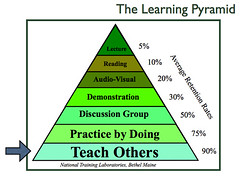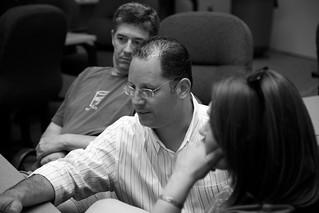Here's what Alan said:
I need your help. I have found an assertion repeated on thousands of web sites, and repeated so often that it is cited as a fact, yet I have tried and tried and have been unable to locate the actual source of this claim:
Research at 3M Corporation concluded that we process visuals 60000 times faster than text.In the interest of dogged pursuit, information literacy, and all that we value as scholarship (okay I am laying it on)- can you help me find the answer? Or spread to someone who can?
Here's what I found ...
I started with the search engine millionshort.com by eliminating the first million hits from Google I circumvented the lions share of SEO (Search Engine Optimized) sites and took a first stab at the deeper web.
The 6th & 7th link struck me as worth following, the 7th link included a citation “The Power of Color in Presentations:”. (http://www.sspweb.com/SSP/visual_lit/VisualLitOnline.pdf) I thought the inclusion of a colon here was odd, probably someone doing a quick "cut & paste". I followed the link to a middle school student's paper. In the bibliography she cites a presentation by Ian Jukes. (Not the one I've included in that link. Its a pdf; page 8.) I first heard the "60 000 times faster than text" claim from him several years back in St. Louis at a workshop for administrators.
One more comment about that student's paper, look at where it's hosted; www.sspweb.com. Looks like a software solutions company. Why would a Middle School kid's paper be there? I did a little digging (go look at their About page). I suspect it's likely her teacher's website.
The link to the Ian Jukes reference is dead, I tried several ways of getting at it but didn't work too hard as I really wanted another source although he might have included some bibliographical info in there somewhere I suppose.
Another search and I found the 3M web page for "The Power of Color in Presentations":
http://www.3rd-force.org/meetingnetwork/readingroom/meetingguide_power_color.html
There is no mention of the "60 000 times faster than text" research.
I did another regular Google Search for:
3m “The Power of Color in Presentations”
(quotes included; I removed the colon)
I found a link to a Google Books search:
In the book "They Snooze You Lose" by Lynell Burmark she cites the source as:
http://www.presentations.com/deliver/audience/1998/05/13_fl_psy_01.html
I looked up the link, which was dead, but the date (May 1998) struck me.
A custom Google Search for dates between 1 Jan 1900 and 31 Dec 1998 lead me to what I thought was the original presentation at 3M where I found this quote (below) in the transcript of a presentation given by Jenn Manalo, Sr. Product Specialist, 3M Corp. This talk was given at St. Louis College Valenzuela on 31 Aug 1998 (I used my browsers "find" command to search for the number 60 and five clicks of "next").
"Humans can process an outstanding amount of visual information. Actually, we can process at 60,000 times faster than text."
Looking up that specific quote using each of the different options at millionshort or a regular Google search returns one result; that very same web page.
Now, let's look up Jenn Manalo, Sr. Product Specialist, 3M Corp.
No fruitful results from pipl.com or linkedin.com or anywhere really. I found several Jenn Manalos in the Philippines. I suspect Jenn is Filipino because she uses two Tagalog words in her talk "matandang mayamang" (old rich) and the url from the archive of her talk has a Philippines root (.ph). Also, St. Louis College is in Valenzuela, Philippines. None of the LinkedIn profiles I found have a Jenn Manalo ever working at 3M.
Lastly I used the "site" command and Googled:
site:http://www.3m.com Jenn Manalo
Nothing.
So it seems Jenn said it; maybe even said it first. (Her talk is dated 31 Aug 1998 and the date embedded in the link from the citation in Lynell Burmark's book points to May 1998 ... there's more work to be done here.) She said "research shows …" a number of times in her archived talk but did not say so for the "60 000 times faster than text" fact; although it is in quotation marks as though she's quoting another source. (Then again, it might be the redactor quoting Jenn.) She may have worked for 3M in the late 1990's and she gave a talk on effective presentations at St. Louis College in Valenzuela, Philippines.
| Learning Pyramid (Photo credit: dkuropatwa) |
All this reminds me of the Learning Pyramid hoax and another time I was "awarded" a Top 100? blog.
Good luck with the search Alan. I can't wait to learn what more you find. ;-)
UPDATE: Getting Closer
I realized I hadn't limited my original Google Search to the 1 Jan 1900 - 31 Dec 1998 time frame. So I went back and did that.
First hit was this pdf: Read 180 Aligned to No Child Left Behind hosted at scholastic.com (a subsidiary of the McGraw Hill publishing company). The research collected here is in support of their Read 180 literacy product. Direct from the pdf:
Media Researchers have found that humans process visual information 60,000 times faster than text, and visual aids can improve learning by up to 400 percent (Burmark, 2004).
I looked into Burmark … actually, I had already started that above. She's the author of You Snooze You Lose I mentioned previously. She apparently mentioned this same "fact" in her 2004 Book, Visual Literacy: Learn to See, See to Learn. In this pdf advertisement for the book she writes: "According to research from 3M Corporation, we process visuals 60,000 times faster than text."
We've already been down that road.
I'm not closer to the source of the research; I'm closer to saying it's an academic legend of the same sort as the Learning Pyramid hoax.
UPDATE: 14 July 2012
Still scratching away at this. I came across the "Pictorial Superiority Effect." These are the results of my digging around:
"Combining pictures with print or audio generally maximizes learning."
Still nothing about "60 000 times faster than text".

- 7/06/2012 01:45:00 pm
- 34 Comments






